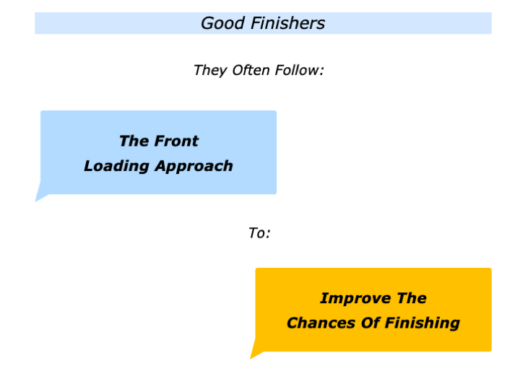
Good finishers rise to the occasion and deliver the goods when it matters. Such people often start, however, by doing an enormous amount of front loading.
This preparation can take different forms and depends on the field in which they perform. Here are some examples that I have seen over the years.
One mediator helped conflicting parties to begin by building on areas of agreement, getting successes and building confidence. One freelancer aimed to bring in more than 60% of their desired income during the first six months of the year.
One business leader always kept a look out for good people and then kept in touch with them. Like a sports coach, they always had a line of people they could call on when vacancies arose. This also gave them the opportunity to replace people without paying fees to recruitment agencies.
One person always kept their bank accounts in the black. They earned enough money to pay for things before buying them and refused to go into debt. Another person kept encouraging others and built enormous goodwill with people. They hoped it would never be necessary to draw on this emotional bank balance.
One sailing crew I worked with rehearsed everything they could before taking part in the actual race. Scheduled to take part in a road-the-world competition, their first meeting was in a damp, cold house without heating. Moving onto the sea, they practiced the routines required to cope with storms in the Atlantic Ocean.
This meant sleeping for an hour, waking up and quickly changing places with their colleagues on deck. They kept practicing until the routine became second nature. They were then ready to deal with the challenges they would face.
Some talented people take the opposite approach. They leave things to the last minute and pull the rabbit out of the hat just before the deadline. This approach gives them an enormous adrenaline kick and can make them the star of the show.
Their team mates can become irritated, however, because this style affects their own work. Many such talented people eventually fall short. They show lots of promise, but fail to deliver the goods on a consistent basis.
Looking at your own life, can you think of a time that you have used aspects of the front loading approach? You may have done this when planning your diary, leading a project, tackling a challenge or doing some other activity.
What did you do to plan ahead, get some early successes and build momentum? What were the benefits of taking this approach? How did it improve your chances of finishing successfully?
If you wish, try tackling the exercise on this theme. This invites you to do the following things.
Describe a specific situation in the past when you used aspects of the front loading approach.
Describe the specific things you did to take this approach.
Describe the specific benefits of taking these steps.
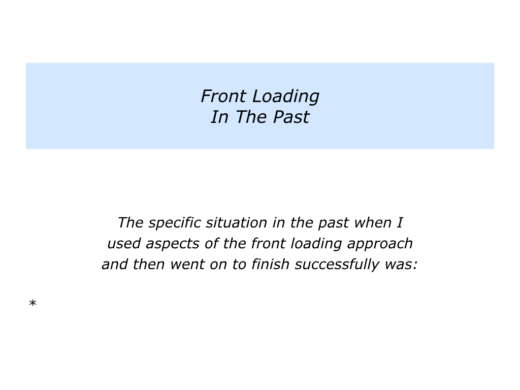
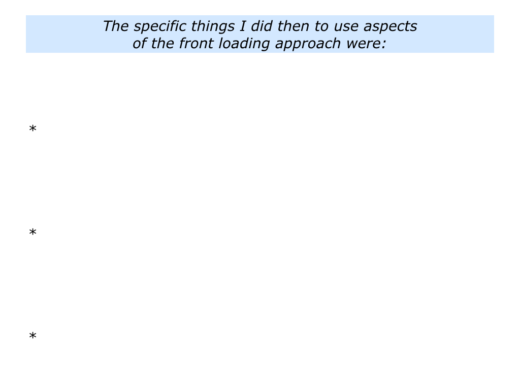
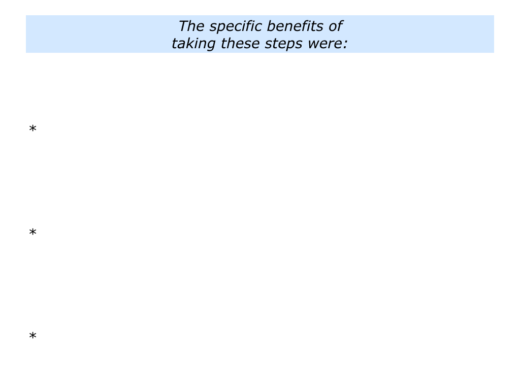
There are many ways to front load things. One person, for example, takes this approach concerning their health. Since the age of 40 they have gone for annual health checks. This paid off by flagging up a potential health problem.
They also visit an osteopath on a regular basis, particularly before embarking on a long stretch of work engagements. They want to feel supple and be able to use their energy in a positive way when doing the work.
Great athletes practice front loading on both the physical and psychological levels. James Kerr describes one such approach in his book Legacy, which is about the New Zealand All Blacks rugby team.
The players are expected to inspire the nation and win every match. Looking at the team’s history, however, this has sometimes led to the players having negative emotions and failing to deliver the goods.
James describes how the players learned to feel calm rather than frantic. They switched to a state they called Blue Head rather than Red Head. Here is an overview of the two states.
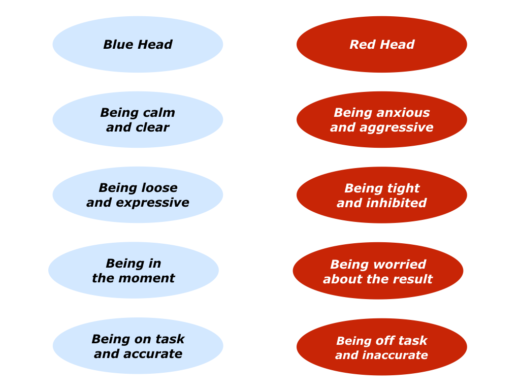
Daniel Coyle, author of The Talent Code, summarised this approach in one of his blogs. Below are excerpts from the piece that you can find via the following link.
http://thetalentcode.com/2014/09/25/a-mental-trick-from-the-worlds-best-team/
Quick background: a few years ago, the team was going through a period of uncharacteristic struggle. Some players were having trouble controlling their emotions in matches.
So, with the help of a former Rhodes Scholar named Ceri Evans, they devised a tool to fix that, built on a simple two-part frame that describes the mental state you want to avoid, and the one you want to be in. They call it Red Head/Blue Head.
Red Head is the negative state, when you are heated, overwhelmed, and tense (H.O.T., in the parlance). Your emotional engine is smoking, your perceptions are slow, the game feels too fast, and your decision making is rushed.
Blue Head, on the other hand, is the precise opposite: the cool, controlled, pattern-seeing state, when you retain your awareness and your decision-making power, when you stay flexible and deliver top performance. The key is doing three things:
Seek to stay in Blue Head as your default setting.
Sense cues when you are entering Red Head mode
Use a physical or mental trigger to get yourself back into Blue Head.
On the All Blacks, each player is encouraged to devise personal triggers to make the transition. One player stamps his feet into the grass, to ground himself. Another uses mental imagery, picturing himself from the highest seat in the stadium, to help put the moment in perspective.
Such teams do a lot of front loading in terms of getting people to practice under pressure. Below is a video in which Ceri Evans, a sports psychologist, describes how the All Blacks took this step.
Here is the official introduction to the piece that was part of Leaders In Sports summit. You can discover more about Leaders, the organisation that holds the summit, via the following link.
http://www.leadersinsport.com/
Ceri is a world-class forensic psychiatrist and sports psychologist.
He helps top athletes reach peak performance, handle pressure and make better decisions and played an integral role in developing the New Zealand All Blacks mental strength during their 2011 Rugby World Cup win.
In this session snippet, Ceri uses an analogy of a surgeon to explain why sports teams should embrace their vulnerabilities to reduce big game pressure and emotional response
One trusted advisor does a lot of front loading in terms of getting work for the future. During the 2008 recession, for example, some of their clients did not have the funds to continue with the regular sessions.
Fortunately the trusted advisor had enough funds to continue meeting with many of these people on a complimentary basis over the next 12 months. These sessions often focused on the key decisions people needed to take to shape successful futures.
The recession passed and many of these people continued with the sessions on a funded basis. Looking back, the informal sessions played a key part in the trusted advisor building up possible work for the future.
Let’s return to your own life and work. Looking ahead, can you think of a situation in which you may want to use aspects of the front loading approach? This could be in your personal or professional life.
You may be aiming to improve your health, build a business, write a book, make a transition, find a more satisfying job or whatever. What can you do to prepare the ground properly and improve your chances of success?
If you wish, try tackling the exercise on this theme. This invites you to do the following things.
Describe a specific situation in the future when you may want to use aspects of the front loading approach.
Describe the specific things you can do then to take this approach.
Describe the specific benefits of taking these steps.
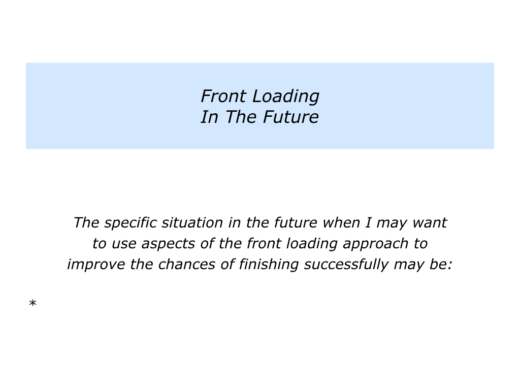
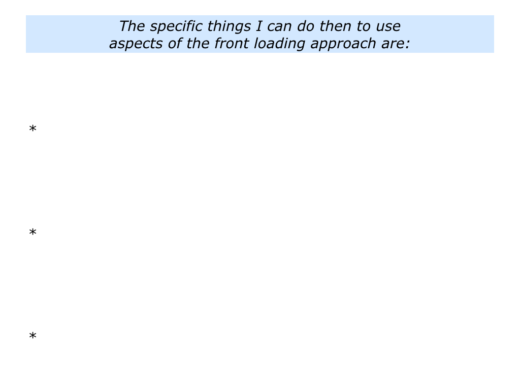
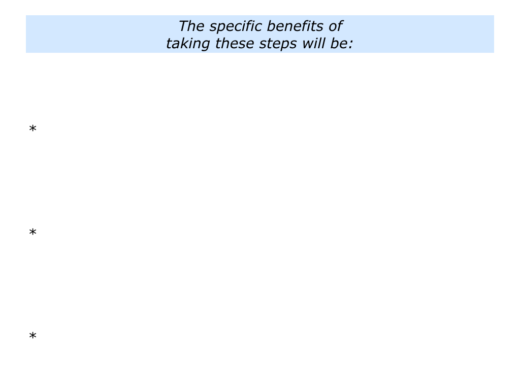






Leave a Reply